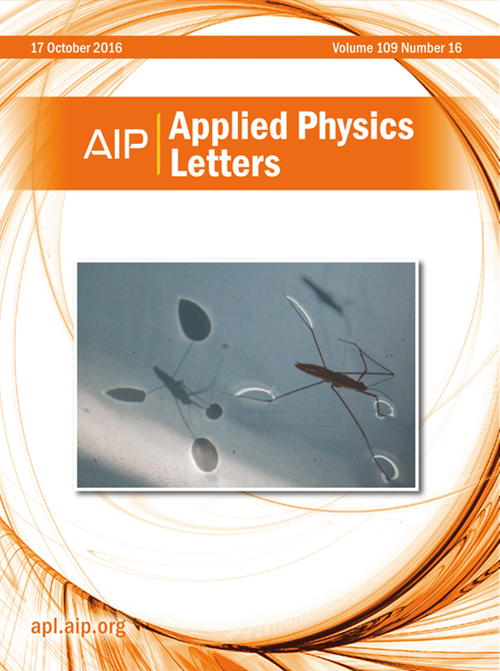二维Rashba半导体和倒置不对称拓扑绝缘体在单层Janus MAA' zxz '(4−x)族
IF 3.5
2区 物理与天体物理
Q2 PHYSICS, APPLIED
引用次数: 0
摘要
Janus结构中的Rashba效应,伴随着非平凡的拓扑结构,在自旋电子学甚至光伏应用中起着重要的作用。本文通过第一性原理计算,系统地研究了135种Janus MAA' zxz '(4−x)族的几何稳定性和电子结构。A = Al, Ga;Z = S, Se, Te)单层,并设计了许多Rashba半导体和反转不对称拓扑绝缘体。具体来说,有26个Rashba半导体在导带最小值处具有由Se/Te-pz轨道贡献的孤立自旋分裂带,Rashba常数的大小与本征电场和自旋轨道耦合(SOC)强度密切相关。随着原子序数的增加,Janus MAA' zxz '(4−x)的带隙不断减小,直到当考虑SOC时,带反转发生,导致带隙重新打开,具有非寻常的拓扑相。结合能带反演,在费米能级附近的pz轨道可以引入双Rashba分裂,具有独特的杂化自旋织构,可以通过较小的双轴应变进一步有效地调节,并表现出从拓扑到非拓扑的连续演化,伴随着不同的自旋织构。这项工作为Rashba和拓扑物理学提供了重要的见解,并进一步为非线性光电子学的发展提供了不可或缺的反转不对称材料。本文章由计算机程序翻译,如有差异,请以英文原文为准。
Two-dimensional Rashba semiconductors and inversion-asymmetric topological insulators in monolayer Janus MAA'ZxZ'(4−x) family
The Rashba effect in Janus structures, accompanied by nontrivial topology, plays an important role in spintronics and even photovoltaic applications. Herein, through first-principles calculations, we systematically investigate the geometric stability and electronic structures of 135 kinds of Janus MAA'ZxZ'(4−x) family derived from two-dimensional MA2Z4 (M = Mg, Ga, Sr; A = Al, Ga; Z = S, Se, Te) monolayers and design numerous Rashba semiconductors and inversion-asymmetric topological insulators. Specifically, there are a total of 26 Rashba semiconductors with isolated spin-splitting bands contributed by Se/Te-pz orbitals at conduction band minimum, and the magnitude of the Rashba constant correlates strongly with both the intrinsic electric field and the strength of spin–orbit coupling (SOC). As the atomic number increases, the bandgap of Janus MAA'ZxZ'(4−x) continually decreases until it shrinks to a point where, when SOC is considered, band inversion occurs, leading to a reopening of the bandgap with nontrivial topological phases. In conjunction with band inversion, pz orbitals near the Fermi level can introduce double Rashba splitting featuring a distinctive hybrid spin texture, which can be further effectively adjusted through small biaxial strains and show a continuous evolution from topological to non-topological accompanied by different spin textures. This work provides significant insights into Rashba and topology physics and further presents indispensable inversion-asymmetry materials for the development of nonlinear optoelectronics.
求助全文
通过发布文献求助,成功后即可免费获取论文全文。
去求助
来源期刊

Applied Physics Letters
物理-物理:应用
CiteScore
6.40
自引率
10.00%
发文量
1821
审稿时长
1.6 months
期刊介绍:
Applied Physics Letters (APL) features concise, up-to-date reports on significant new findings in applied physics. Emphasizing rapid dissemination of key data and new physical insights, APL offers prompt publication of new experimental and theoretical papers reporting applications of physics phenomena to all branches of science, engineering, and modern technology.
In addition to regular articles, the journal also publishes invited Fast Track, Perspectives, and in-depth Editorials which report on cutting-edge areas in applied physics.
APL Perspectives are forward-looking invited letters which highlight recent developments or discoveries. Emphasis is placed on very recent developments, potentially disruptive technologies, open questions and possible solutions. They also include a mini-roadmap detailing where the community should direct efforts in order for the phenomena to be viable for application and the challenges associated with meeting that performance threshold. Perspectives are characterized by personal viewpoints and opinions of recognized experts in the field.
Fast Track articles are invited original research articles that report results that are particularly novel and important or provide a significant advancement in an emerging field. Because of the urgency and scientific importance of the work, the peer review process is accelerated. If, during the review process, it becomes apparent that the paper does not meet the Fast Track criterion, it is returned to a normal track.
 求助内容:
求助内容: 应助结果提醒方式:
应助结果提醒方式:


